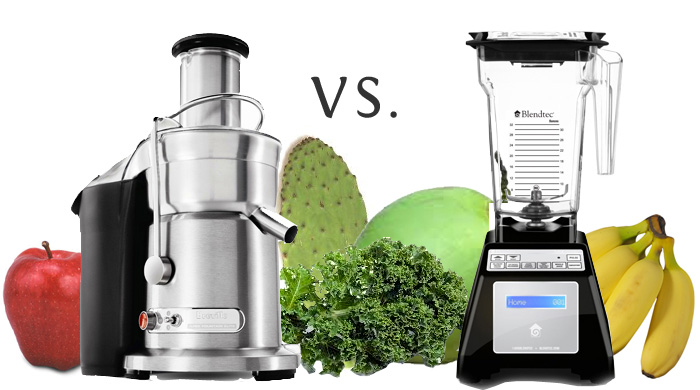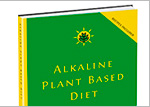Juicing Vs. Blending Fruits And Vegetables

I studied both sides of the juicing vs. blending fruits and vegetables argument. I have to point out that both blending and juicing have their benefits, but blending is the better option.
The benefit of blending and juicing is we are able to consume much more fruits and vegetables than if we were to eat them whole. This results in saturating the body with nutrients and phytonutrients that support health, vitality and homeostasis in the body.
Juicing Vs. Blending
Juicing is the process of removing the vitamins and minerals from the fiber, leaving a juice full of vitamins and minerals. The aim of juicing for the body to digest the juice quicker by removing them from their fiber.
Blending is the process of breaking vegetables and fruits into very small pieces. This allows for faster digestion but not as fast as juicing. Blending retains all the fiber, nutrients, and phytonutrients.
Both processes assist with digestion by breaking down fruits and vegetables so their nutrients and phytonutrients become more bioavailable and enter the blood at a greater rate.
The Western diet is deficient in minerals, vitamins, and phytonutrients, and juicing and blending both help to supply the daily recommended value for these nutrients.
Blending Offers Better Absorption And Usage Of Nutrients
Juicing has been the rave because it strips the nutrients from the fiber, leaving a juice of nutrients. On the surface this seems like a great idea.
The stomach doesn’t have to much work at all, and its digestion happens quickly. The juice travels quickly from the stomach to the small intestine, and from their enters the blood quickly.
Why wouldn’t we want that? Juicing fruits and vegetables has a similar effect on the body as taking vitamin supplement has. The body excretes a lot of the nutrients because they flood the blood to quickly.
The kidneys maintain the required balance of water, electrolytes, and nutrients in the body, and the rate in which the juice enters the blood throws off that balance.
The kidneys have to reduce the spike and remove a lot of the nutrients in its attempt to protect homeostasis in the body.
Blending the same amount of fruits and vegetables vs. juicing them has a different effect. Blending retains the fiber, but breaks it down in smaller pieces.
Breaking the fruits and vegetables breaks down the cell walls of the plant, which allows easier digestion of the nutrients and phytonutrients they contain.
Since the fiber still remains the body has to spend time digesting the fruits and vegetables, but the digestion process is much quicker then eating while fruits and vegetables.
This controls the rate in which the nutrients enter the bloodstream, so it doesn’t spike it. More nutrients also enter the blood compared to chewing the fruits and vegetables, because blending breaks down more of the foods cell walls and allows easier access to its nutrients.
The rate in which blending allows nutrients to enter the blood in comparison to juicing a bit slower, but his actually allows the body to use more nutrients over a longer period of time.
Juicing vs. blending – nutrition absorption: blending wins
Blending Retains The Fiber Which Protects Against…
The USDA recommends that males consume around 35 grams of fiber a day, and females consume around 25 grams of fiber a day.
The Western diet is deficient in fiber. People who consume a western diet only consume on average 14-15 grams of fiber a day.
Consuming the recommended value for fiber provides the following benefits:
- Lowers blood cholesterol levels.
- Combats constipation.
- Reduces the risk of colon cancer.
- Reduces the risk of developing intestinal pouches (diverticula) that trap and putrefy waste in the colon.
- Feeds the good bacteria in the colon the produce butyrate, and strengthen the immune system and lining of the colon.
Juicing vs blending – fiber: blending wins
Appetite
Blending fruits and vegetables keeps their fiber, which makes them take longer to digest than juiced vegetables and fruits.
Blended vegetables and fruits are easier for the digestive process to handle than improperly chewed foods.
By blending you are assisting the digestive process and you are keeping food in the stomach longer than juicing does, which keeps you fuller longer than juicing.
Since juicing leaves you with the only water and nutrients, they quickly pass through the stomach and quickly leave you with an empty stomach.
Juicing vs. blending – appetite: blending wins.
Cleaning
Cleaning the juicer has always been a pain and challenge for me, which is another reason I prefer blending.
I did own a juicer at one time, but I didn’t use it for long. It took too much effort for me to clean it.
I knew juicing was beneficial to my health, but the cleaning process was just too overwhelming. I ended up leaving my juicer under the sink, which unfortunately became the juicer’s cemetery.
I know several people who have fallen into this category, and like me, ended up buying a blender. and fortunately the benefits of. Blending is a breeze. The cleaning process is a breeze. I just add soap and water to the blender, turn it on for thirty seconds and I am done.
Juicing vs. blending – cleaning: blending wins.
Juicing Vs. Blending Fruits And Vegetables
Juicing vs. blending: the winner is blending.
References:
USDA daily fiber recommendation
Get the Facts on Fiber
Tags: benefits of juicing vs blending, juice vs blend, juicing vs blending







